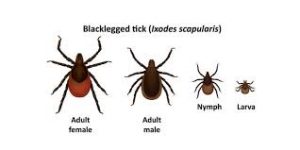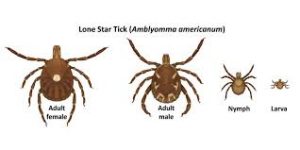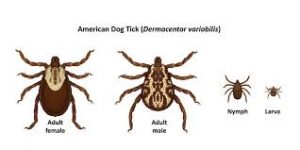With summer in full effect, it’s the perfect opportunity for you and your pets to get outdoors to soak in the sun. Whether you are taking your fur baby for a hike to burn off some energy or for a swim in the lake to cool them off, you should be mindful of the pesky little creature called a tick!
There are 3 types of ticks common to the DMV. They include the Black-legged Tick, American Dog Tick, and Lone Star Tick. All these ticks have a life cycle that contains 3 stages: larvae, nymph, and adult. At the larval stage these ticks have only 6 legs and are about the size of a pen tip. In the nymph and adult stages, they have grown to have 8 legs and can be up to 10 mm in length. They can carry a wide range of diseases which means knowing how to identify them at all stages and sizes is key.

Black-legged Tick (Deer Tick)
Black-legged ticks are also known as “deer ticks.” They get this nickname because they are commonly found on deer in large quantities, but they do pose health risks to humans and animals as well. Black-legged ticks are the primary carrier of Lyme disease so knowing how to identify and remove them is very important. These little buggers are very tiny and as an unfed adult measure up to 5 mm and when fed can be up to 10 mm. Male black-legged ticks are generally all black, hence the name, whereas females have red on their abdomens and may appear darker, even black, after they have had a blood meal. Since these ticks are so tiny, you should be very thorough when checking yourself and your pet. Start at the feet and legs and work your way up. This is because ticks don’t fly or jump, rather they crawl up from the ground onto the body.

Lone Star Tick
The Lone Star tick is known for its interesting physical characteristics as well as aggressiveness to bite. Lone Star ticks are generally 3 to 4 mm in length before a meal and can become twice the size after feeding. Female Lone Star ticks have a reddish-brown body with a white dot resembling a star on the abdomen. When a female has had a meal, she will become engorged, turning a grayish-brown. Males are typically a reddish-brown color with either spots or streaks of white around the outer edges. You may also be able to identify them by the speed in which they travel. Lone Star ticks are very fast movers and can cover a person’s leg or arm in under five minutes. Along with their aggressive behaviors, these ectoparasites (external parasites) are known to carry a disease called STARI, Southern Tick Associated Rash Illness. Be thorough in your head to toe exam of your pet and use the characteristics of the Lone Star tick to your advantage when trying to identify them.

American Dog Tick
As the name suggests, these ticks are frequently found on our furry friends but can attach themselves to humans as well. The American Dog Tick is commonly known to transmit diseases such as Rocky Mountain spotted fever, ehrlichiosis, and babesiosis. With them enjoying a warm, dry environment, they are known for infesting homes if they get carried inside. Between the risk of disease and risk of an infestation, it is important to know how to spot these little guys. An unfed adult tick of this type is generally a reddish-brown color and can measure up to 3 mm. When an American Dog tick has had a blood meal, they turn a bluish-gray and can measure up to 12 mm in length. When checking your pet for them, spend extra time looking inside the ear and in between the toes as this is the most common place for this type of tick to attach itself. On the other hand, immature American Dog ticks are often found feeding along the back. With them still being very tiny at this stage, be extra thorough when examining your pet’s back.
Knowing how to spot and identify a tick is crucial for you and your pet. As a pet parent, you should take preventative measures to avoid any risks to your furry loved one. So, what can you do to protect them against these pests this season? Spot-on treatments, oral medications, shampoos, tick dips, tick collars, powders, sprays, and home and lawn treatments are all readily available on the pet market. Always remember to do your research and consult your veterinarian when choosing the proper prevention for your pet!
Have you found ticks on your pet? What kind? Where did they pick them up? Tell us in the comments.
Passionately Pets has been a trusted pet care provider in Northern Virginia since 2007. We proudly provide dog walking, pet sitting and overnight services for dogs, cats and other companion animals in Arlington, Alexandria, Annandale and Falls Church. Visit our website, www.passionatelypets.com, to request a consultation or more information. For more pet filled content, follow us on Instagram and like us on Facebook @passionatelypets.




Leave a Reply